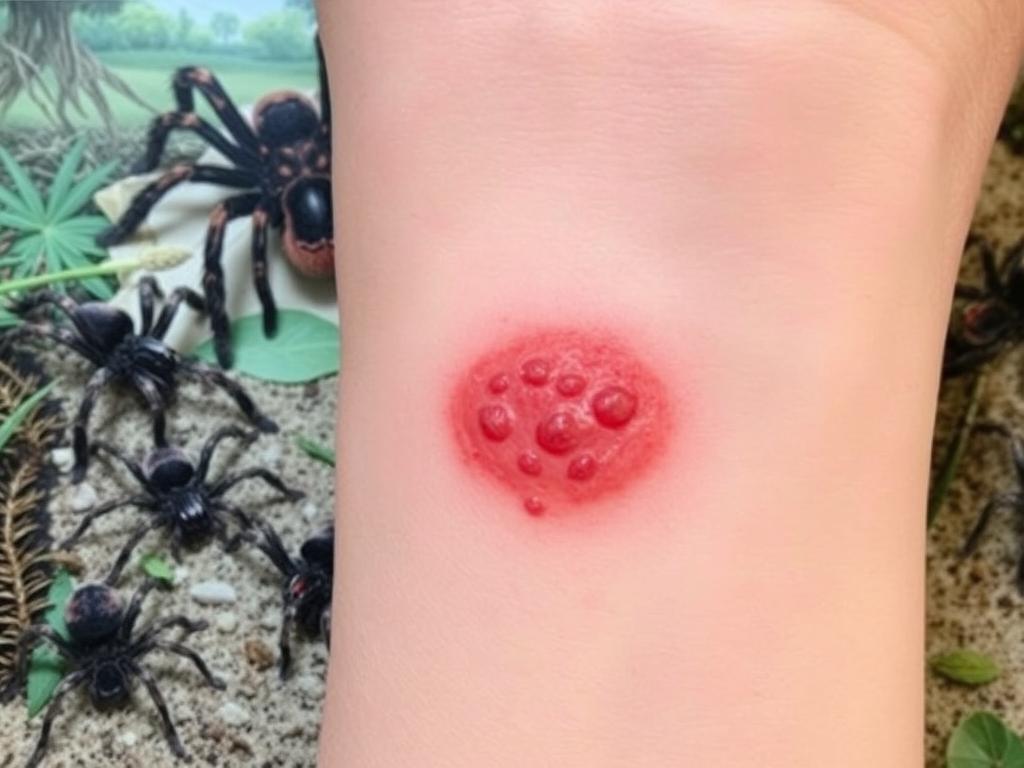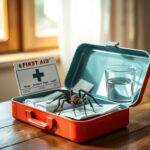Professional Resources and Guides on Tarantula Bites

If you love tarantulas or have one as a pet, you might know a lot about them. But what do you do if a tarantula bites you? Venomous tarantulas can be dangerous, and knowing how to react is key. This guide will give you the expert advice and resources you need to handle tarantula bites safely.
Are you an experienced tarantula owner or just starting to learn about them? You’ll find all the answers here. We cover everything from how tarantula venom works and what symptoms to watch for to what to do in an emergency. This guide is packed with vital information that could save a life or ease your worries next time you meet a tarantula.
Tarantula Venom Effects and Symptoms
Tarantulas can be a worry for pet owners and outdoor fans. These spiders are often seen as harmless, but their venom can be strong. Knowing about the effects and symptoms of tarantula bites is key for staying safe and giving the right first aid.
Understanding the Potency of Tarantula Venom
In the Americas, tarantulas like the Poecilotheria genus have strong venom. This can lead to a painful and dangerous bite. On the other hand, Old World tarantulas from Asia and Africa have less toxic venom. They are less likely to cause severe reactions in people.
Some of the most venomous tarantulas are the Poecilotheria (Ornamental Tree Spiders), the Haplopelma (Earth Tigers), and the Phoneutria (Brazilian Wandering Spiders). These spiders have venom that can cause pain, swelling, and redness. In rare cases, it can lead to more serious issues.
Common Symptoms of Tarantula Bites
The usual signs of a tarantula bite are:
- Localized pain and swelling at the bite site
- Redness and inflammation around the bite
- Mild to moderate discomfort or tingling sensation
- In rare cases, more severe reactions like nausea, vomiting, or difficulty breathing
If you think you’ve been bitten by a tarantula, get medical help right away. This is especially true if you have any worrying symptoms or are allergic to spider bites. Quick treatment can help manage the venom’s effects and prevent further problems.

Venomous Tarantula Species: A Comprehensive Guide
The world of venomous tarantulas is vast and diverse. Many species have different levels of venom potency. It’s important to know the differences for enthusiasts and those who want to avoid risks with tarantulas. This guide will cover the geographic distribution, physical traits, and venom strength of key venomous tarantula species.
Black Widow Spider (Latrodectus): Bite, Symptoms, and FactsThe Poecilotheria genus, also known as the “Ornamental” or “Ornamental Tree” tarantulas, is well-known. These spiders live in parts of India and Sri Lanka. They are famous for their bright colors and patterns. Their venom can cause severe pain, swelling, and in some cases, life-threatening reactions.
| Venomous Tarantula Species | Geographic Distribution | Venom Potency |
|---|---|---|
| Poecilotheria (Ornamental Tree Tarantulas) | India, Sri Lanka | Potentially Dangerous |
| Poecilotheria regalis (Regal Ornamental) | India | Potentially Dangerous |
| Acanthoscurria geniculata (Brazilian Salmon Pink Birdeater) | Brazil | Mildly Venomous |
| Brachypelma smithi (Mexican Red-Knee Tarantula) | Mexico | Mildly Venomous |
The Poecilotheria regalis, or Regal Ornamental, is another important species. It lives in parts of India and is very venomous in the Poecilotheria genus.
The Acanthoscurria geniculata, or Brazilian Salmon Pink Birdeater, and the Brachypelma smithi, or Mexican Red-Knee Tarantula, have milder venom. They are less of a threat to humans. These tarantulas are popular with enthusiasts because they are not as dangerous.
Knowing about the different venomous tarantula species helps people make safe choices when they meet or handle these spiders. It’s important to take safety steps to protect both the tarantula and the person handling it.
Tarantula Bite Guides
Understanding and addressing tarantula bites is crucial. These tarantula bite guides offer key insights. They help identify bite marks and suggest first aid steps.
Identifying Tarantula Bite Marks
Spotting tarantula bite marks is the first step in handling a bite. These bites leave two puncture wounds with swelling or redness. Look closely for these signs to know if it was a tarantula.
First Aid for Tarantula Bites
Clean the wound with soap and water if you think you’ve been bitten. Use a cold compress or ice pack to reduce swelling and pain. Watch for signs of envenomation like more pain, redness, or other worrying symptoms.
Seek medical help if symptoms get worse or don’t go away. These tarantula bite guides prepare you for safety and health if bitten.
Tarantula Bite Prevention Strategies
Owning a tarantula means keeping both you and your pet safe. To prevent bites, learn how to handle them safely and create a secure home. These steps help lower the chance of bites and make owning a tarantula rewarding.
 Initial Home Treatment for Tarantula Bites
Initial Home Treatment for Tarantula Bites
Safe Handling Techniques for Tarantulas
Handling tarantulas needs patience, care, and knowledge. Know how your tarantula acts before touching it. Don’t move suddenly, as this can scare the tarantula and make it bite.
Use a strong container or tongs to put the spider on your hand or arm. Don’t touch the tarantula directly to avoid stress and bites. If the tarantula gets upset, put it back in its safe place fast.
Creating a Secure Tarantula Habitat
A secure home is key to keeping your tarantula safe. Make sure the enclosure is locked well, with no way for the tarantula to escape. Add things like substrate, hides, and places to climb to make it a good home.
Check the habitat often for any holes or weak spots. Fix them right away. Don’t touch the tarantula when it’s molting, as this can make it bite.
By handling tarantulas safely and keeping their homes secure, you can enjoy these amazing creatures. This way, you and your pet can live together happily.
Antivenoms and Medical Treatment for Tarantula Bites
When dealing with serious tarantula bites, tarantula antivenoms are key. These antidotes neutralize the venom of certain tarantulas. It’s vital to get medical help fast, as severe bites can be deadly.
Antivenoms bind to and block the toxins in tarantula venom. But, not all places have these antidotes, and not all tarantulas need them. Sometimes, just managing symptoms like pain and swelling is enough until the venom wears off.
| Tarantula Species | Antivenom Availability | Potential Severity of Bite |
|---|---|---|
| Poecilotheria (Ornamental Tree Spiders) | Antivenom generally available | Potentially life-threatening |
| Grammostola (Tarantulas) | Antivenom may be limited | Moderate to severe |
| Brachypelma (Mexican Red Knee Tarantulas) | Antivenom often not available | Mild to moderate |
If a tarantula bite is serious, seek medical attention right away. Doctors can check how bad the bite is and give the right treatment. They might give antivenom to fight the venom’s effects. Quick action can help you recover fully and avoid serious problems.
Legal Considerations and Resources for Tarantula Ownership
As a tarantula enthusiast, it’s key to know the laws about owning them. Laws change based on where you live, so make sure to check and follow them. You might need permits or licenses, so get those if you have to.
 Using Antihistamines for Tarantula Bites
Using Antihistamines for Tarantula Bites
There are many resources out there to help you with tarantulas. Look for groups of tarantula fans, conservation groups, and schools. They offer great advice, news, and a chance to meet others who love tarantulas too.
Being a responsible tarantula owner means caring for your pets and knowing the laws. Stay updated and take action to make sure you’re doing the best for your tarantulas. This way, you’ll take good care of your pets and follow the law easily.


